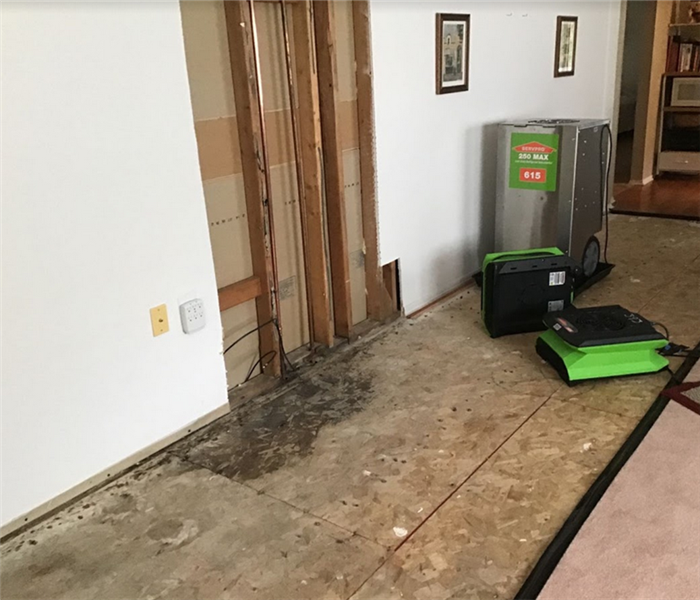What Happens to My Toms River Home When a Pipe Bursts in the Wall?
9/13/2020 (Permalink)
 Water damage can quickly affect both the contents and structure of your home. Contact SERVPRO 24/7 for remediation services.
Water damage can quickly affect both the contents and structure of your home. Contact SERVPRO 24/7 for remediation services.
Plumbing breaks can be devastating for Toms River homes, impacting several materials.
Between freezing conditions that can cause pipes to burst or the corrosion and degradation of lead/copper pipes standard in older homes in Toms River, a broken portion of plumbing could be devastating for your property. These situations can be overwhelming to witness, but deliberate action taken immediately can reduce continued damage to the house and absorption into exposed materials. Shutting off the water supply to your property and contacting a professional water restoration company like our SERVPRO team is the best solution for protecting a structure and its contents.
Water damage in Toms River homes that results from a plumbing break can quickly move through structural cavities and impact multiple materials. Because our roster is well-rounded with both Water Restoration Technicians (WRT) accredited through the Institute of Inspection, Cleaning and Restoration Certification (IICRC) and building trade professionals, we can provide homeowners a comprehensive solution for water damage recovery. Assessing the damage to both the utility and the house requires more direct access to the affected areas, typically from controlled demolition.
Can Controlled Demolition Help After a Pipe Break?
Because of how rapidly the situation can get out of control, our general contractors can quickly remove affected portions of drywall and other exposed materials. The objective of eliminating parts of damaged wall systems and discarding these elements is extensive. There are three main reasons why controlled demolition is a practical path to efficiently restore and recover your home after a substantial water disaster in Toms River:
- Repairs to Plumbing – One of the initial advantages of removing drywall and other wall system elements is the immediate access to broken portions of plumbing. Our general contractors can work quickly to restore water service to the property with this unrestricted access.
- Removing Saturated Carpeting – Carpeting can often be quickly damaged by the presence of water, specifically because it is a hygroscopic material. Its composition quickly absorbs moisture, allowing it to mildew or produce mold that destroys its ability to be salvaged.
- Direct Access for Drying – Removing portions of the wall where damage has existed is a direct point of access for drying tools and equipment in our inventory. Centrifugal air movers and positive pressure systems can benefit from pathways to where evaporative drying is necessary.
What Materials Become Damaged by Water?
Almost any material exposed to standing water can become damaged. Some of the affected structural elements and contents in your home are more susceptible and sensitive to this absorption and damage than others. Understanding which materials are most likely to experience the worst of the effects on a shorter timeline can focus our technicians with controlled demolition and repairs at the right points. Individual structural elements are almost guaranteed to become damaged when pipes burst within the walls of your home. These include:
- Drywall – Removing drywall panels provide access to damaged areas and expose wood framing for drying and antimicrobial treatment.
- Insulation – Insulation is often thoroughly saturated. Because it is a material that can be easily replaced, it should get vacuumed or pulled out and discarded for easier access to needed repairs.
- Carpet/Padding – Pulling up carpeting based on its saturation and wetness prevents the entire room from becoming affected. Often the padding must get removed as well to provide direct access to subflooring.
- Subflooring – While drying is ideal, OSB board or plywood can become warped and distorted and require cutting out and replacement. Once removed, supports and joists can get treated with antimicrobial products to inhibit mold growth while drying gets underway.
In the Photo Illustration, our techs moved back the carpet to dry the sheathing with air movers and an LGR dehumidifier, restoring rather than replacing these elements. The wall cavity is prepared for the installation of new drywall.
How Does Mold Growth Get Addressed if It is Found?
Prolonged moisture exposure can often lead to the development of microbial threats and fungal colonization. Mold is often unavoidable when drying does not complete in a specific timeline. With so many materials exposed and saturated by plumbing breaks within your home walls, preparing for mold remediation is often advisable. We have experienced remediators on our roster that can respond along with our restoration technicians to ensure that the appropriate measures get taken to remove colonies thoroughly and safely. To accomplish removing mold colonies and their effects, we have several approaches, including:
- Surface Treatment
- Controlled Demolition
- Deodorization after antifungal application
As immediately threatening and overwhelming as a pipe burst in the wall could be, there are ways that you can protect more of your home and its contents. Quickly securing experienced and helpful professionals like our SERVPRO of Toms River team can ensure that the right steps get taken to make water disasters “Like it never even happened.” Give us a call today at (732) 349-9898.




 24/7 Emergency Service
24/7 Emergency Service